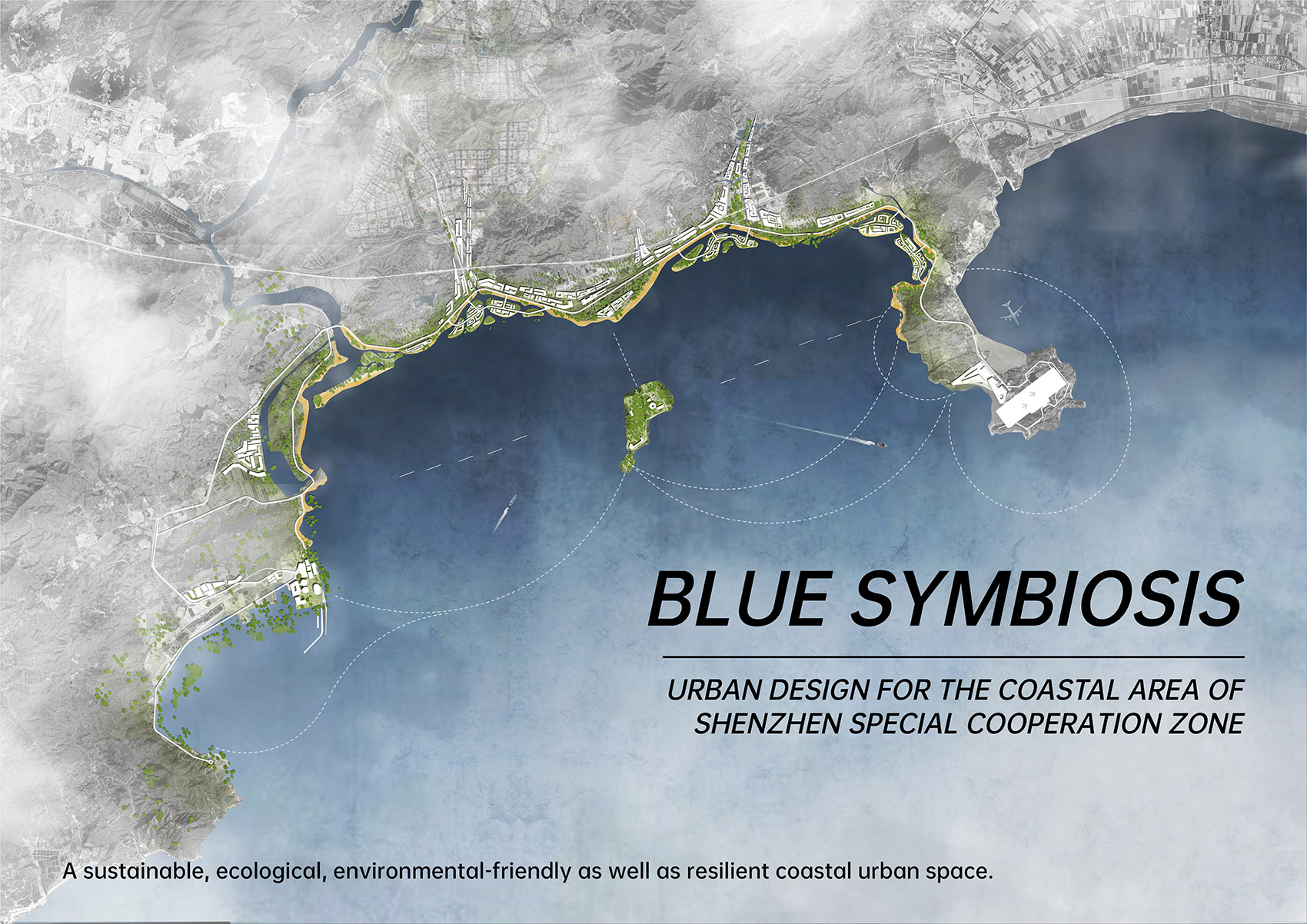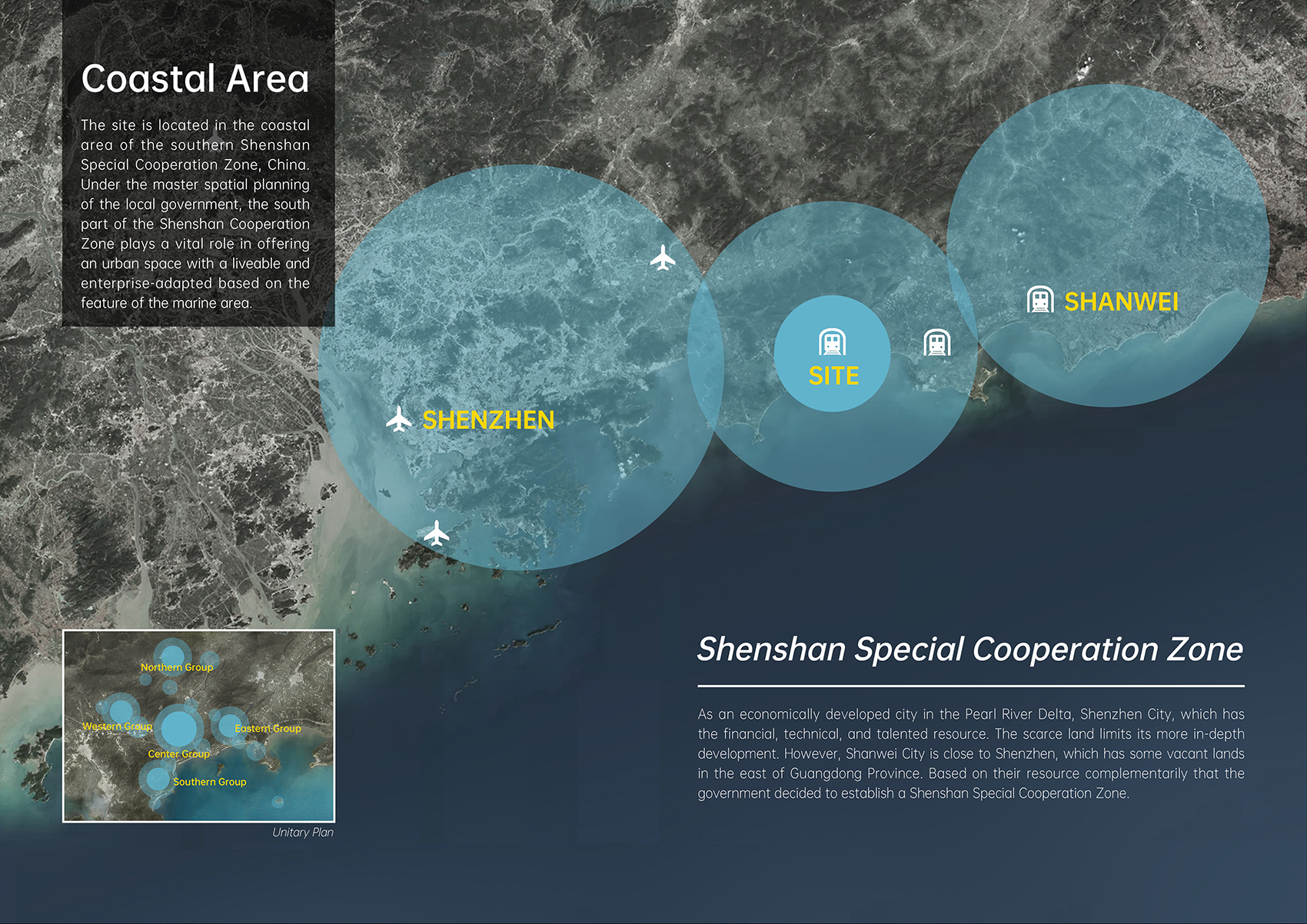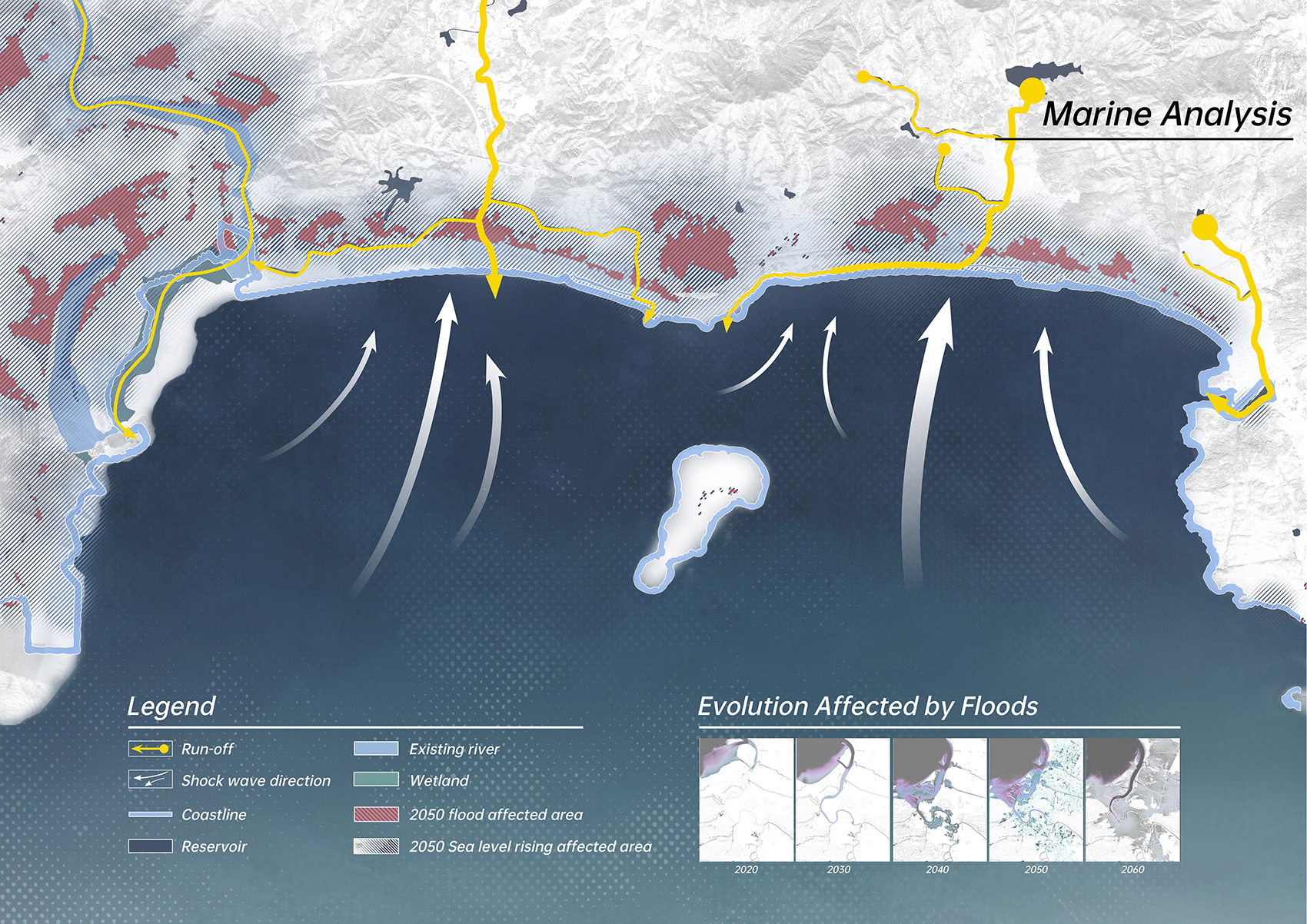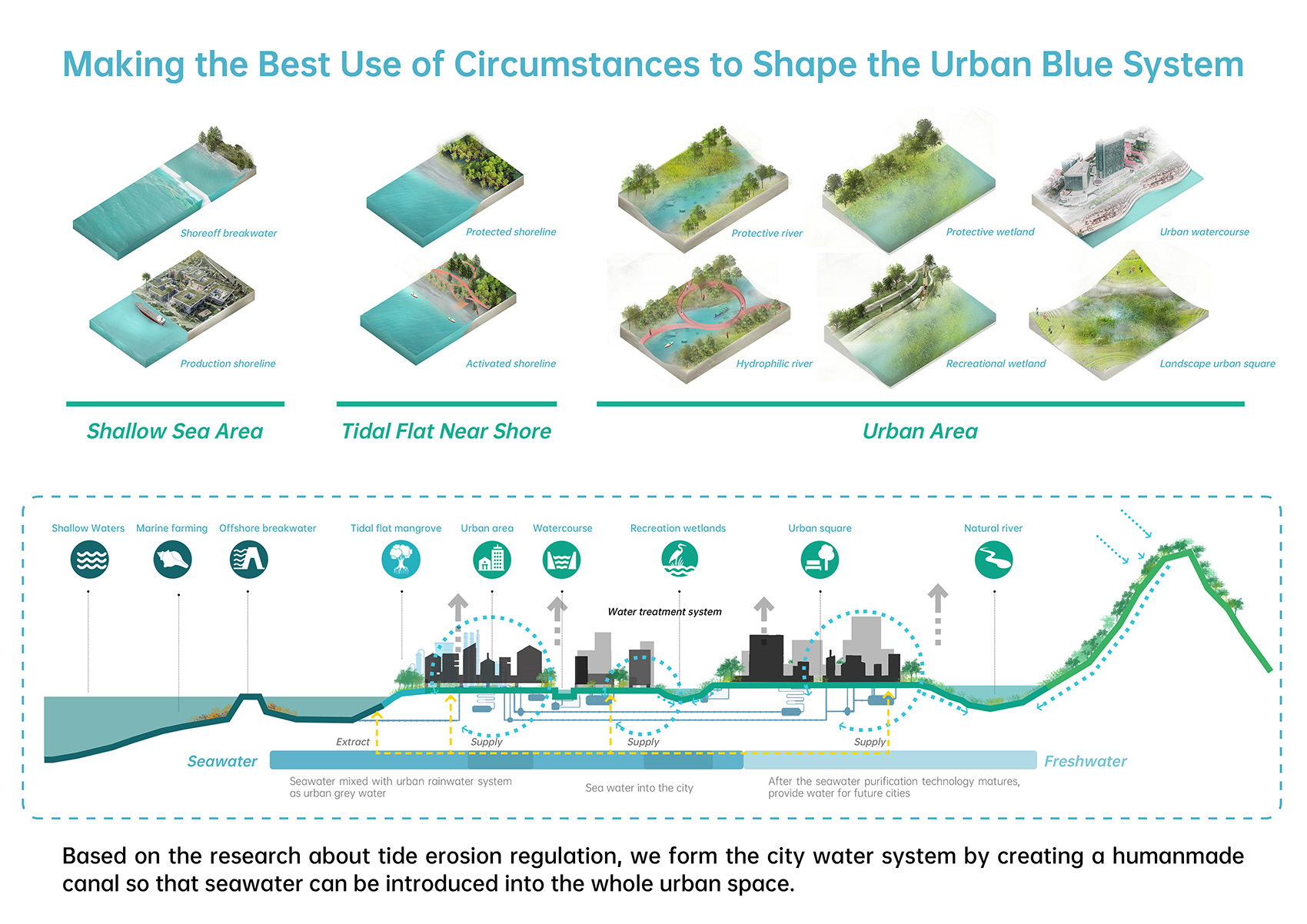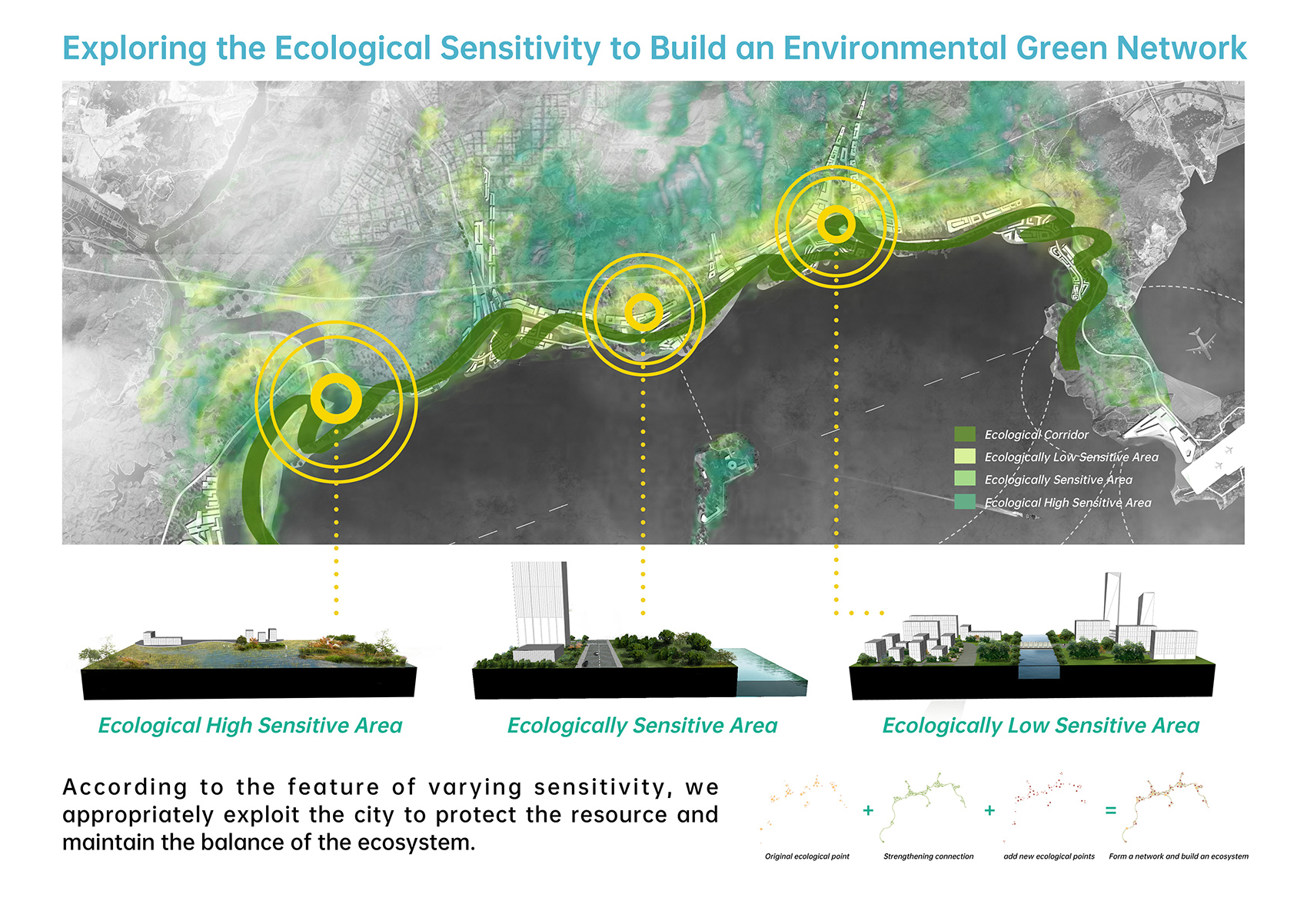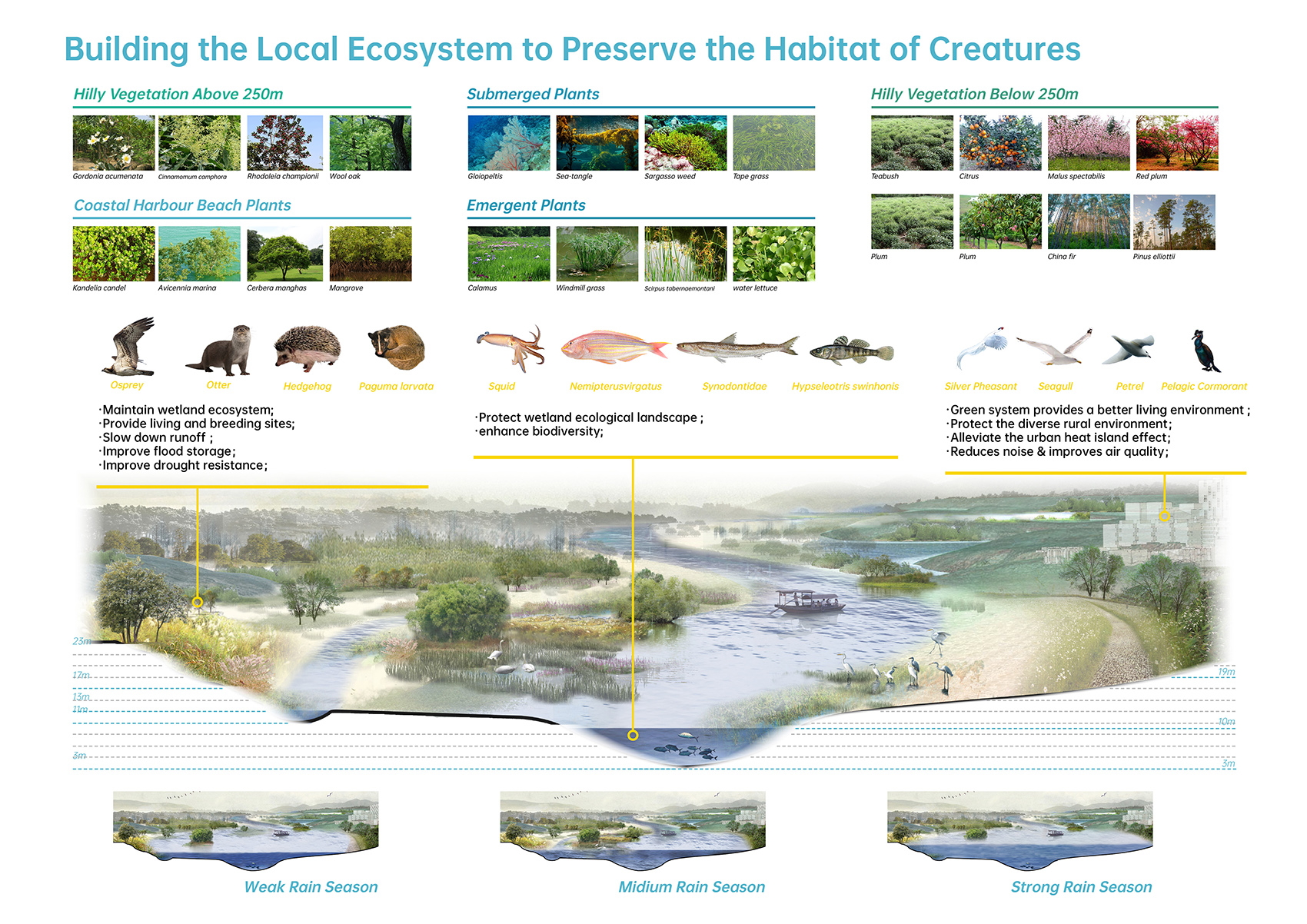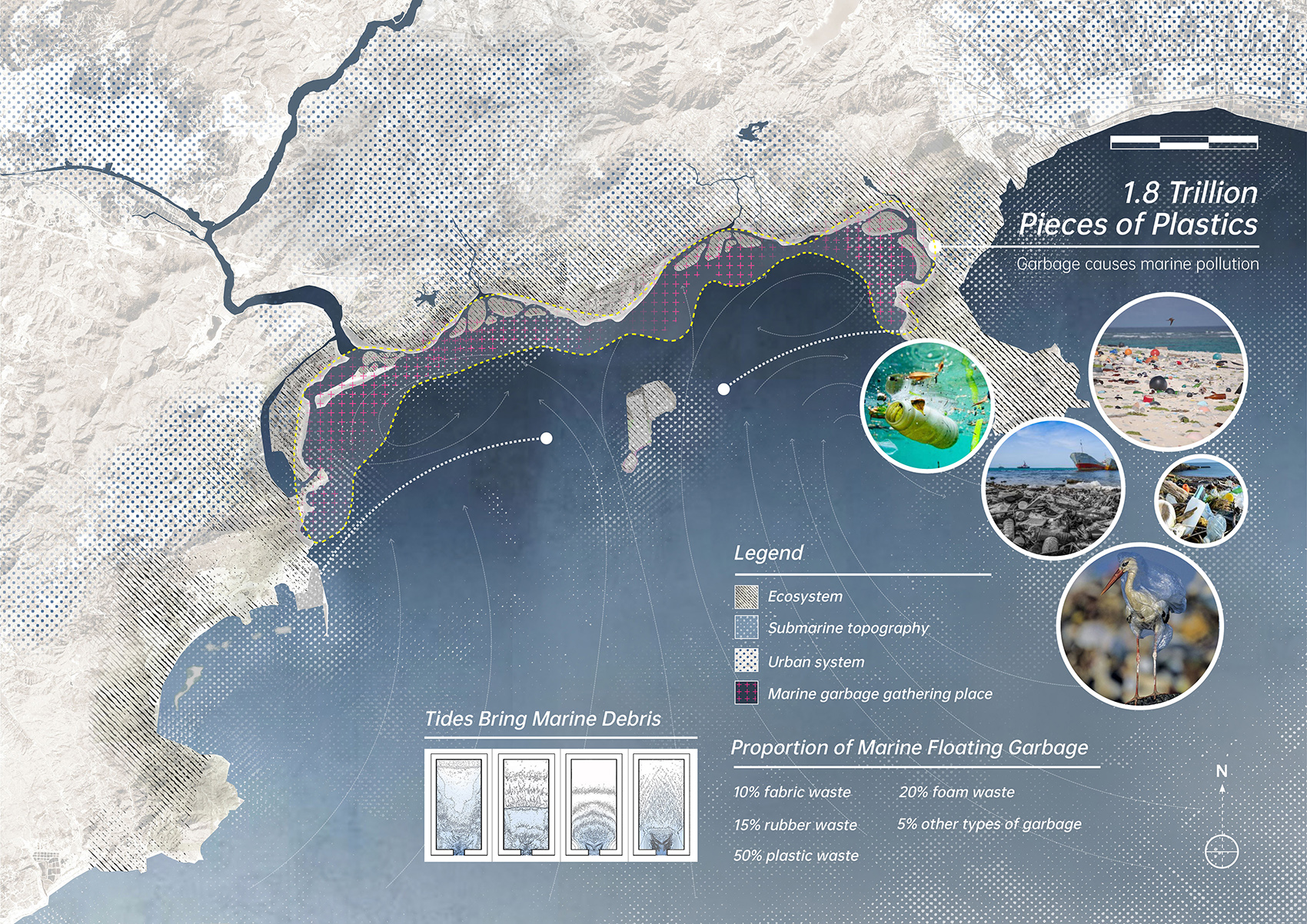项目位于深圳汕尾特别合作区的南部——滨海区域。在政府对发展新区总体空间规划下,南部地区承载着以在地性“滨海“特色为基,创建宜居、宜业城市空间的重任。我们面临着严峻的挑战:场地环境复杂恶劣、生态系统脆弱,区域发展滞后、自然灾害频发。缘此,我们提出“引海入城”,通过建立稳定良好的生态系统,提高区域对自然灾害的抵御力、适应力及修复力,增加生物多样性,保护动植物栖息地等;同时,我们前瞻性解决易被忽视的引海入城存在的海洋垃圾问题,极力打造可持续性、生态型、友好型韧性滨海城市空间。
The site is located in the coastal area of the southern Shenshan Special Cooperation Zone, China. Under the master planning from the local government, the south part of the Shenshan Cooperation Zone plays a vital role in offering an urban space with a liveable and enterprise-adapted based on the feature of the marine area. Nowadays, we are facing the rigorous challenges such as the complex and terrible environment of the site, the weak ecosystem, the backward urban development as well as natural disasters. Therefore, we came up with an idea of introducing the seawater into the city, through establishing a stable and safe ecosystem to improve the capacity to respond to natural disasters, to enrich the diversity and to protect the habitats of creatures, etc. Meanwhile, we solved the problem of ocean garbages proactively, which was easy to be ignored when implementing our idea. We will create a sustainable, ecological, environmental-friendly and resilient coastal urban space.
▼总平图,site plan ©环球地景

深圳市作为珠三角区的经济发达城市,具有资金、技术、人才等优势,但土地资源稀缺;汕尾市接壤深圳,是粤东第一土地大市,但经济发展滞后。因深圳与汕尾具有资源高度互补性,缘此建立了深汕特别合作区,其对两市经济发展具有重要战略地位与意义,被称为“深圳市第10+1区”。如何创建宜居、宜业城市,吸引人才聚集创新,同时保护在地生态文化资源,创造具有深汕特色的新城区,是深汕特别合作区一系列城市设计任务的关键,临海的南部区域尤其具有在地性挑战。
As an economically developed city in the Pearl River Delta, Shenzhen City, which has the financial, technical, and talented resource. However, the scarce land limits its more in-depth development. Shanwei City is close to Shenzhen, which has some vacant lands in the east of Guangdong Province. Based on their resource complementarily that the government decided to establish a Shenshan Special Cooperation Zone.
▼区位图,Site Analysis ©环球地景
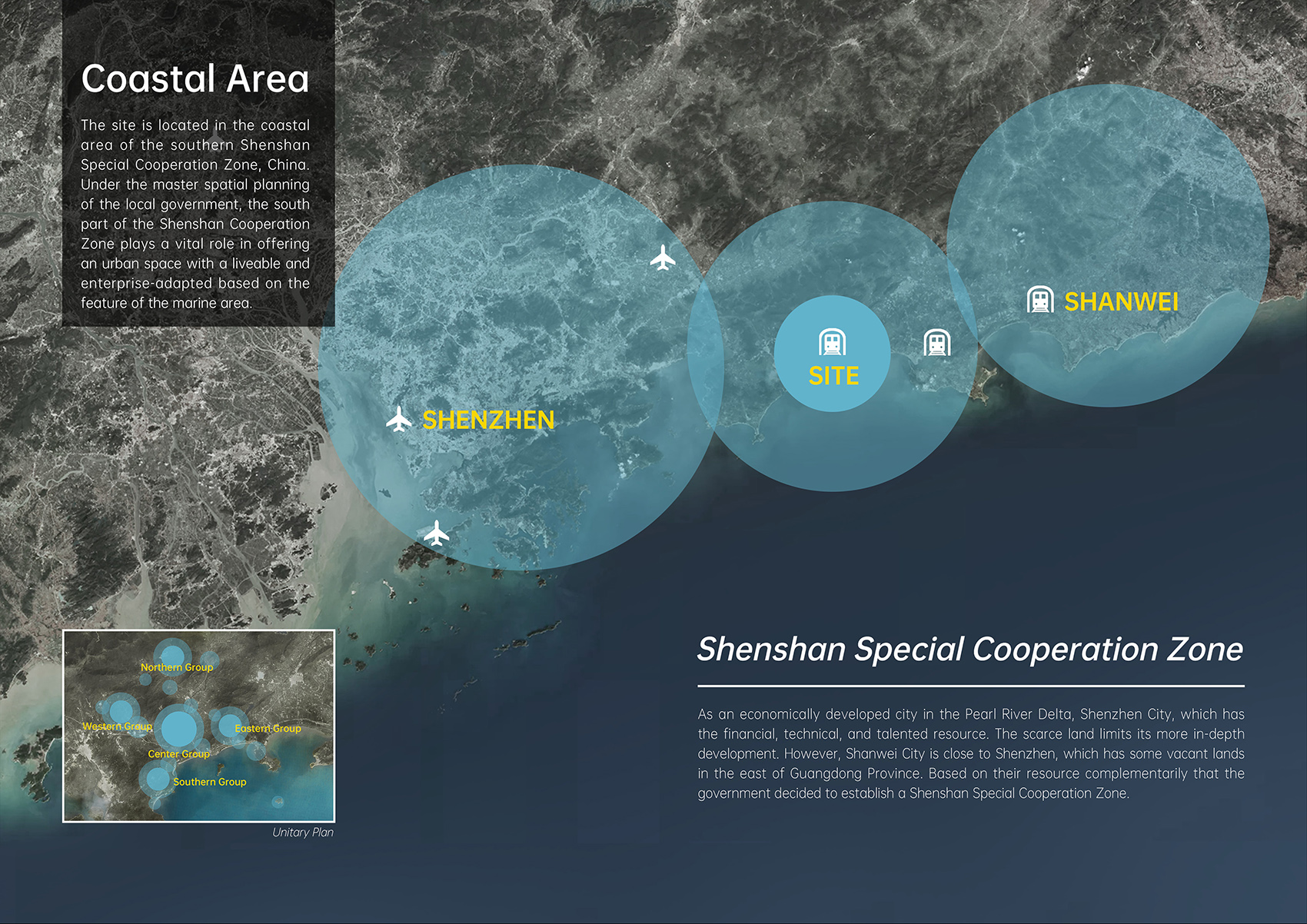
1、海岸侵蚀导致动植物原生栖息地受损; 2、山洪灾害频发,人类生活及生态环境遭受冲击; 3、海平面上升破坏生态环境,影响城市发展,加剧海洋灾害; 4、海洋垃圾问题突出,环境污染严重,且危害航行安全; 5、当地发展未考虑生态参与,导致湿地消失,植被自然演变缓慢。
1. Coastal erosion and loss of original habitat of creatures 2. Flooding issue and breaking of human living environment 3. Sea-levelling rising and marine disaster 4. Ocean garbage and pollution 5. Disappearing of wetland and slow-down evolution of vegetation
▼海洋分析,Marine Analysis ©环球地景
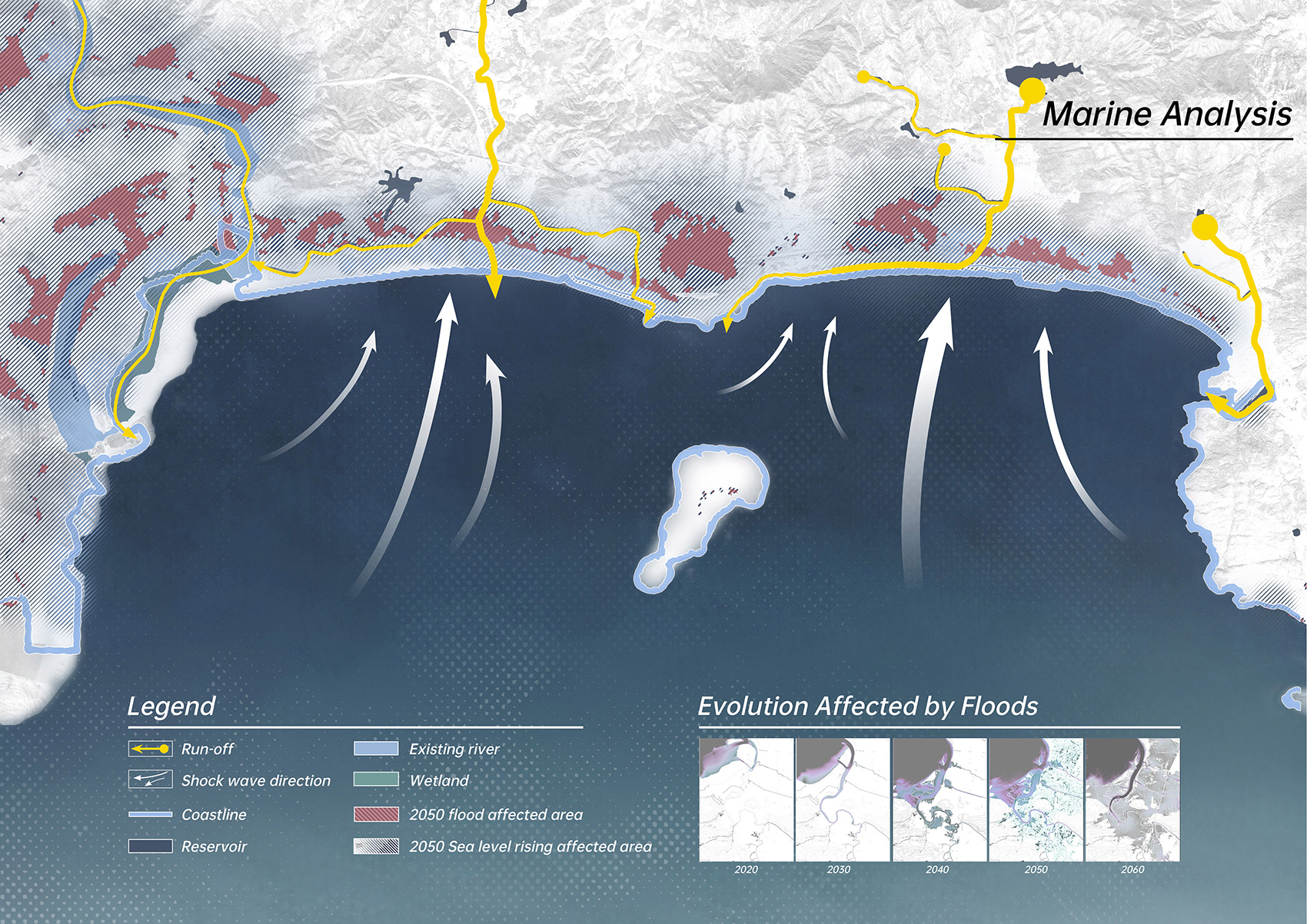
人类活动与生态环境相依互存。根据本案滨海区域特质,我们立足生态,以“引海入城”的设计手法平衡海洋与城市关系,在一定限度内针对未来可预见性的自然灾害进行预判性人为防控,通过打造城市蓝绿网络,低影响构建稳定良好的生态系统,增强城市抵御、适应及修复能力,疏解人与自然、海洋间的发展矛盾,实现“蓝色·共生”。
There is a close interaction between human activities and ecological environments. Considering the feature and ecology of the site, we balanced the relationship between ocean and city in the method of introducing seawater into the city. It carries out predictive human-made prevention and control for the foreseeable natural disasters to some extent. A stable and functional blue-green system enhances the city’s capacity of resistance, adaptation, and restoration. At the same time, the healthier system realizes the goal of “Blue Symbiosis.”
▼低影响城市生态系统,Low Impact Urban Ecosystem ©环球地景

根据滨海城市特性,利用引海水系划分城市三大功能区域:浅海—滩涂岸线—城市。通过研究海洋潮汐侵蚀规律,开掘人工河道,初步形成城市水网,海水引入后进入城市水处理系统作为城市二级生活用水,未来可实现进一步处理后转淡水供应。同时,城市水网与现有湿地、河道等水体进行串联,最终形成完善的生态蓝网,实现有效的海洋灾害防护、海岸线生态保护及城市亲水性环境打造。
Based on the research about tide erosion regulation, we form the city water system by creating a humanmade canal so that seawater can be introduced into the whole urban space. A part of seawater could be mixed with urban rainwater collective system as greywater to some extent. It could be purified into drinkable water in the future. At the same time, we connect the existing water bodies like wetlands and rivers to complete the entire blue system. It not only can reduce the impact of marine hazards and protect coastal line but also provide a hydrophilic space for the citizen.
▼构建生态蓝网,Making the Best Use of Circumstances to Shape the Urban Blued System ©环球地景
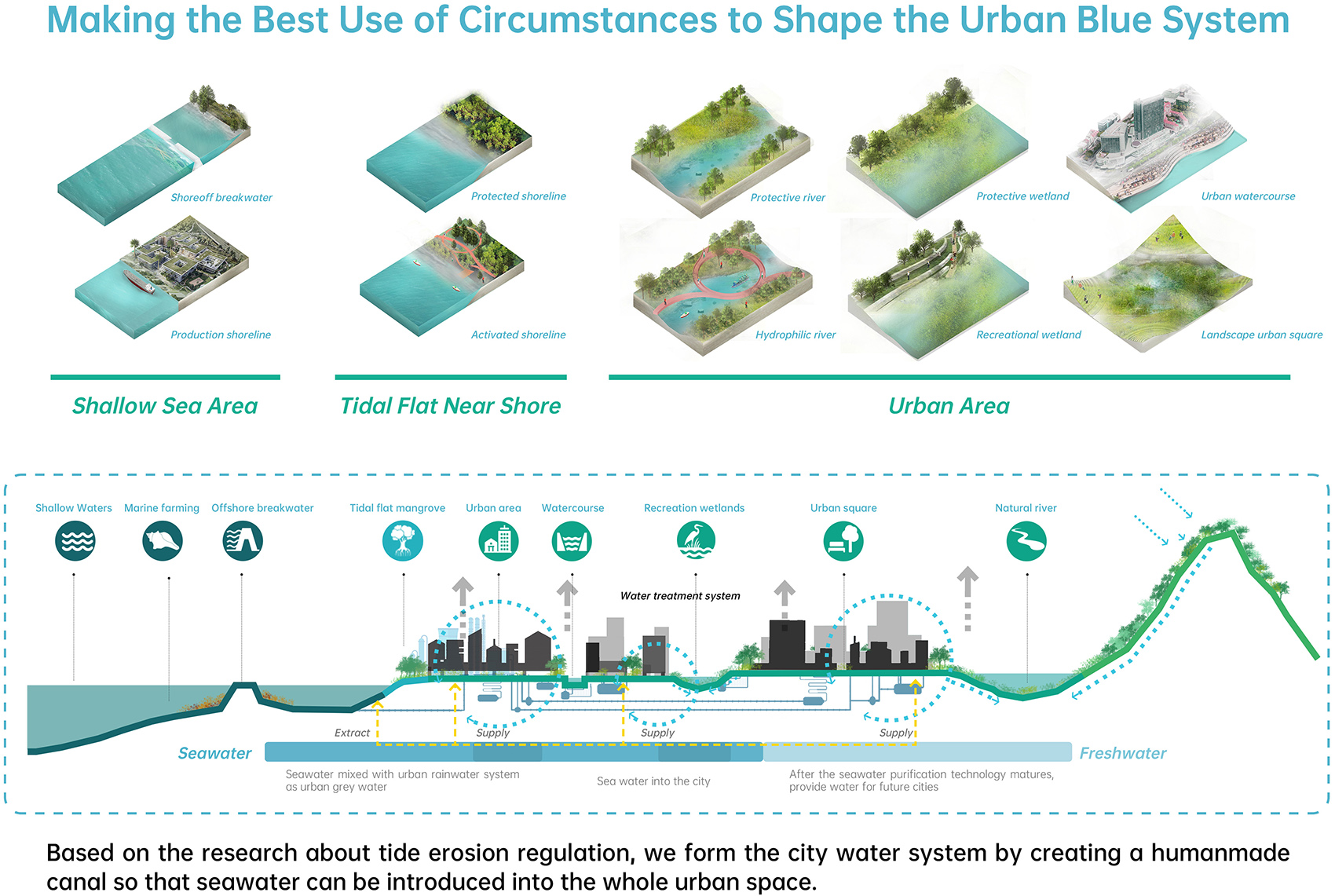
通过Arcgis生物敏感分析,确定区域高、中、低生态敏感区,根据其区域各自特性,在城市建设中进行针对性、节制性资源开发利用,最大限度保护生态系统,维持生态平衡,提高径流雨水的渗透、调蓄、净化、利用和排放能力,疏解城市内涝灾害,保护水资源、提供游憩,构建生态连廊。
We ensured three ecologically sensitive zones from low to high by ArcGIS. According to the feature of varying sensitivity, we appropriately exploit the city to protect the resource and maintain the operation of the ecosystem. Besides, it improves the capacity of infiltration, storage, purification, utilization, and discharge of runoff rainwater, relieves urban waterlogging, protects water resources, provides a recreational place and builds ecological corridors.
▼搭建生态绿网,Exploring the Ecological Sensitivity to Build an Environmental Green Network ©环球地景
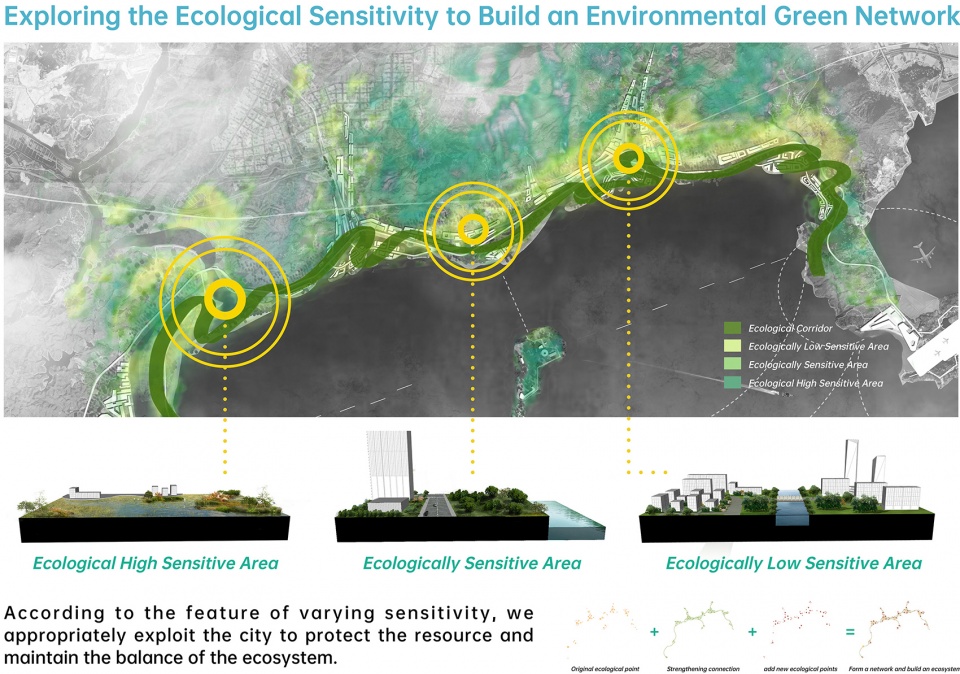
研究在地原生动植物系统,分析区域生态系统链中因人为因素造成缺失或缺少的种类,针对性进行原生种类补充,增加生物多样性,保护生态湿地,创造动植物适宜的栖息场所,形成完整的生态系统自净修复链,保证自然生态系统的结构的复杂性与稳定性。同时缓解城市热岛效应,建立自然灾害生态抵御系统。
Researching the local animal and plant category and analyzing missing species in the regional ecosystem chain by human factors. According to that situation, we enrich the type of species, increase the biodiversity and protect the natural wetland. A suitable living space for various creatures and an entire self-cleaning ecological chain formed on the site. Meanwhile, the system we build will alleviate the urban heat island effect and defence the natural disaster to some extent.
▼搭建在地生态系统,实现动植物栖息保护,Building the Local Ecosystem to Preserve the Habitat of Creatures ©环球地景

海洋垃圾是一个全球性的问题,危害着海洋环境和生态系统,尤其以南海沿线国家表现最为严重。引海入城存在一个易被忽视的问题点:势必将增加海洋垃圾对城市生活的影响。故而,应预判性先期解决潜在威胁。观察发现:海洋冲击波将海洋垃圾从海域带到了城市岸线,在冲刷点位上形成垃圾堆积。据此,在浅海域布设海洋垃圾桶,利用风能带动垃圾桶内部产生气旋进行垃圾收集,减少海洋垃圾污染对海洋生态的影响。同时,收集起的海洋垃圾可进行进一步分解处理,实现废弃物的重生再利用。
Ocean garbages is becoming a global hazardous issue. With the arrival of the tide, a large amount of garbages was brought and accumulated. Notably, in countries along the South China Sea. Ocean garbages can be easily overlooked when introducing water into the city, which has a severe impact on the urban ecosystem and living environment. Therefore, we have to tackle this unavoidable threat proactively. We collect the garbages by installing garbages bins with a fan on the sea. The garbage bin is driven by the wind and produce cyclone inside that can obtain garbages. It will be decomposed and treated to realize the regeneration and reuse of waste.
▼海洋垃圾问题,Issues — Marine Floating Garbage ©环球地景
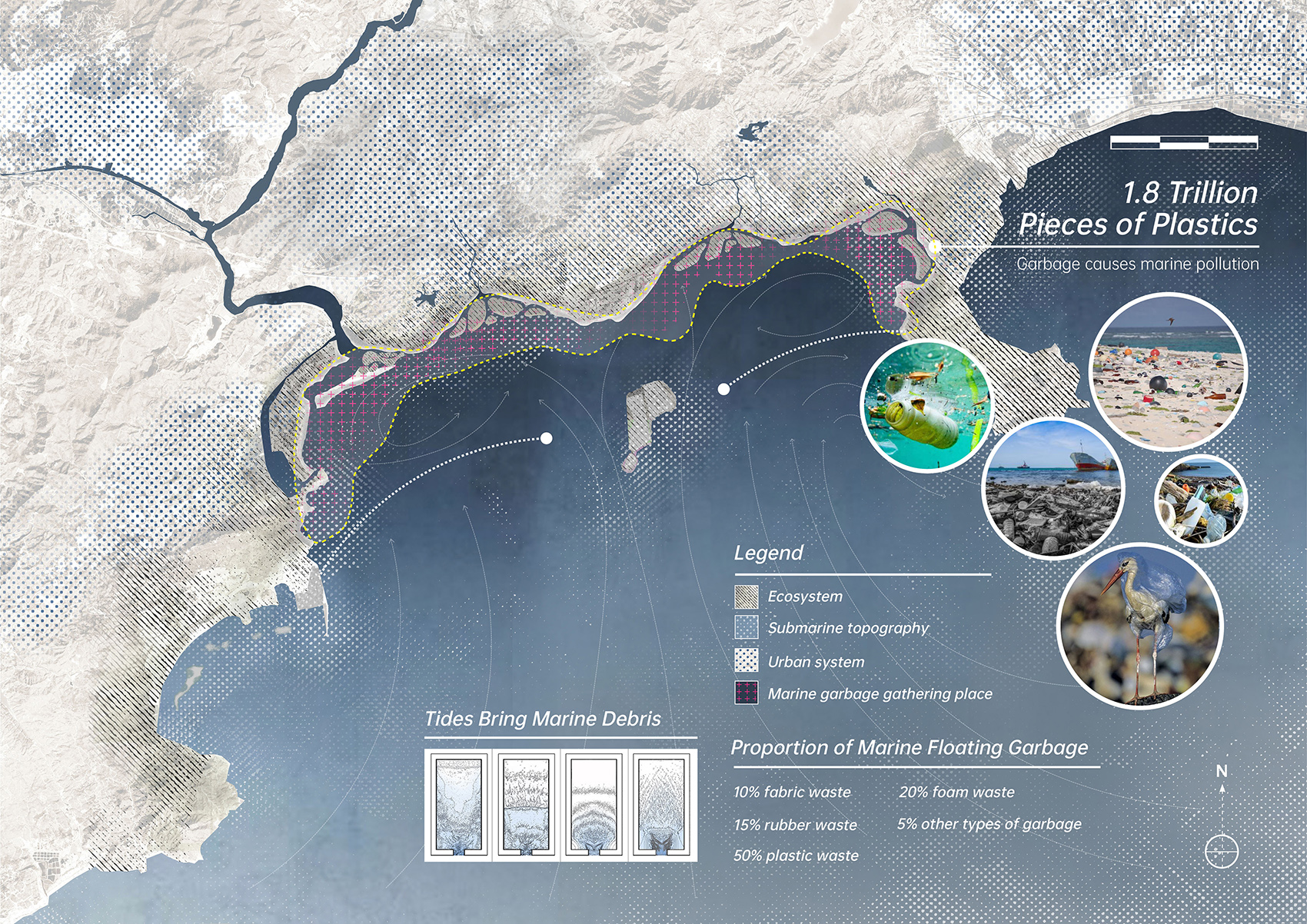
▼海洋垃圾处理机制,Marine Garbage Disposal Mechanism ©环球地景

深汕特别合作区滨海地区以“蓝色·共生”为畅想,将“引海入城”融入城市设计,构建城市“海洋蓝网”与“生态绿网”。与此同时,我们前瞻性地处理“蓝绿网交织”时可能出现的隐患——海洋垃圾对生态和城市的影响。我们的设计构想有效地利用海洋特质平衡城市发展与生态环境的冲突,为滨海城市设计提供了创新性思路,同时预判性防控潜在危机,实现长期的、可持续的、友好的城市与自然共生发展,其理念具有重要的参考意义与价值。
Taking the “Blue Symbiosis” as a blueprint of Shenshan Special Cooperation Zone, we apply a conception of introducing seawater into the city to build an urban blue and green system. At the same time, we solve a threat proactively when we portray the system. Our design alleviates the contradiction between urban development and the environment effectively. Meanwhile, the conception provides a creative thinking pattern for building a sustainable and resilient coastal metropolitan area.
*该项目已获得2020 IFLA AAPME分析规划类荣誉奖 the project has been awarded Honourable Mention in IFLA AAPM 2020
